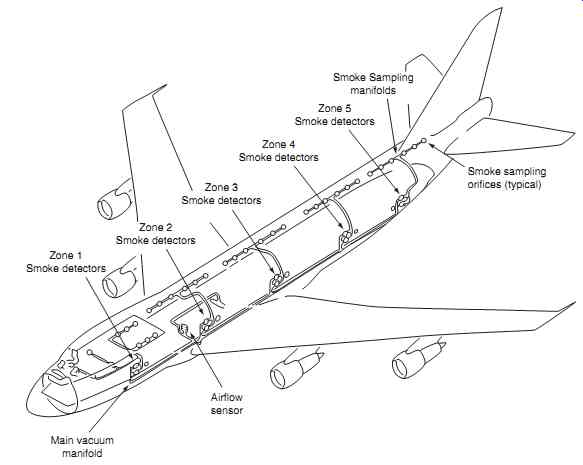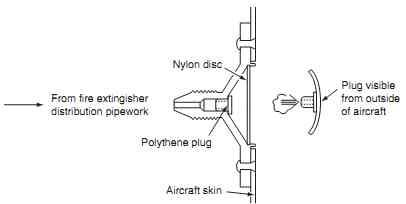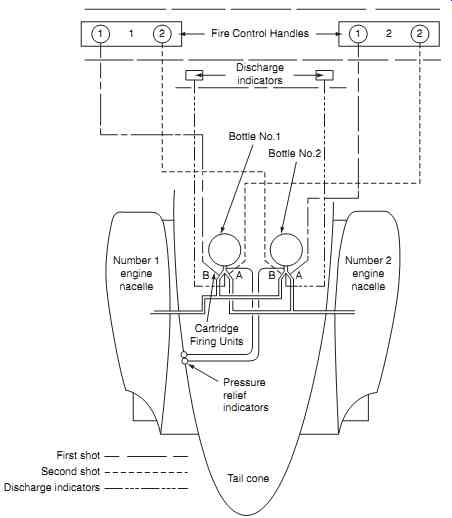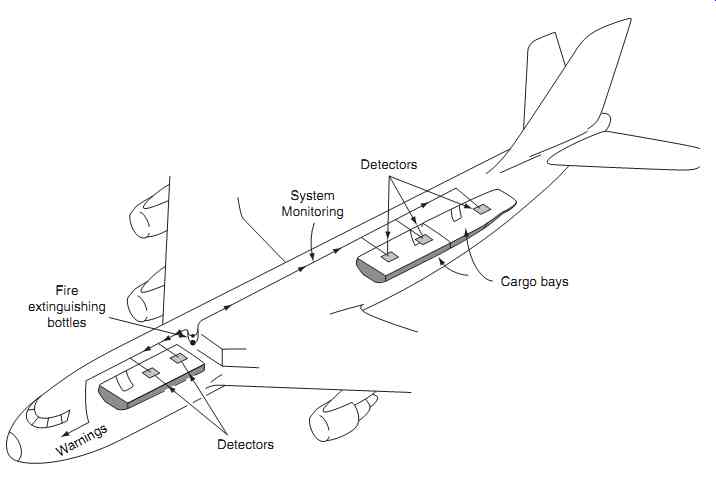AMAZON multi-meters discounts AMAZON oscilloscope discounts
(cont. from part 1)
3. Cargo bay/baggage area
The most likely source of fire in the aircraft cargo bay or baggage compartment is from organic materials; the detection method in widespread use is the smoke detector. The primary design consideration for this application is ensuring that the smoke reaches the detector in a timely way. Open area smoke detectors rely on the transfer of particulate matter from the source of fire to the detector by convection. Smoke from burning materials in cargo/ baggage areas often stratifies; in the early stages of a cargo/baggage fire there is insufficient heat energy to cause the smoke to rise through convection. Smoke will eventually accumulate in the roof area of the cargo/baggage area and so this is where the detectors are located. In larger cargo/baggage areas several detectors will be installed to speed up the detection time, which can be up to 60 seconds. In some aircraft, air samples are taken from numerous locations and supplied to a centralized ducted smoke detector.
=============

FIG. 11 Optical smoke detector principles
Light reflected to photoelectric cell by smoke particles Air out Air in Photoelectric cell Light trap Test Lamp/LED Air sample input Mounting feet (2) Air sample output Smoke particles Labyrinth Beacon lamp/LED
=============
3.1 Smoke detector principles
There are two basic principles used in smoke detectors: ionization and photoelectric.
3.1.1 Ionization smoke detectors
The ionization type monitors ionized products of combustion as they pass through a charged electrical field. This type of smoke detector can detect particles of smoke that are often too small to be visible. The
detector uses a very small amount of radioactive isotope that is a source of alpha radiation. The radiation passes through an air-filled chamber between two electrodes; this radiation allows a low constant current to flow between the electrodes. Smoke entering the chamber absorbs the alpha particles, thereby reducing the ionization and interrupting the current; this interruption is used to trigger a warning circuit.
Ionization smoke detectors can be manufactured at a lower cost compared with optical detectors; however they have several disadvantages:
-- they will also go into an alarm if dust and/or fine water droplets enter the chamber
-- the detector's sensitivity changes with pressure, i.e. altitude changes and also with age.
3.1.2 Photoelectric smoke detectors
Photoelectric smoke detectors measure light attenuation and/or reflection within a chamber. An air sample is passed through the detector via ducts, or pipes, see FIG. 11. This air sample passes trough a labyrinth chamber. A photoelectric cell is located at right angles to the light beam; when smoke particles enter the chamber, some of the light is reflected and scattered off the particles, causing energy to fall on the second cell.
Early types of photoelectric smoke detectors used a low-voltage incandescent light bulb projecting light across the chamber with a photosensitive cell on the other side of the chamber. Incandescent lamps do not have a very long life; this reduces the overall reliability of the detector. Modern aircraft smoke detectors now use a light-emitting diode (LED) as the light source. The smoke detector can be tested by illuminating an internal LED that simulates the deflected light.
Some aircraft use open area detectors where the smoke samples pass directly into the chamber. Open area cargo bay smoke detectors are arranged through the aircraft as shown in FIG. 12.
Main deck freighter aircraft typically use ducted smoke detectors installed as shown in FIG. 13. This configuration has a pair of smoke detectors per zone connected via orifices connected via manifolds.
A centralized vacuum manifold draws air through all of the smoke detectors. Alarms are given on a zoned basis when smoke enters through any of the sampling orifices.
A classification process approach is used to develop the fire protection strategy for cargo bay/baggage areas. The safety requirements are specified according to each class of compartments (A through E). Class A cargo or baggage compartments are compartments where:
-- the presence of a fire would be easily discovered by a crew member while at his/her station; and
-- each part of the compartment is easily accessible in flight.
Class B cargo or baggage compartments are typically used on aircraft carrying a combination of cargo and passengers on the same deck. In these compartments:
-- there is sufficient access during flight to enable crew members to reach any part of the compartment with the contents of a hand fire extinguisher when the access provisions are being used, no hazardous quantity of smoke, flames, or extinguishing agent will enter any compartment occupied by the crew or passengers there is a separate approved smoke detector or fire detector system to give warning at the pilot or flight engineer station.
Class C cargo or baggage compartments are typically compartments below the main deck of an aircraft, or on the same deck as passengers, but are not readily accessible. In these compartments:
- there is a separate approved smoke detector or fire detector system to give warning at the pilot or flight engineer station
- there is an approved built-in fire extinguishing or suppression system controllable from the cockpit there are means to exclude hazardous quantities of smoke, flames, or extinguishing agent from any compartment occupied by the crew or passengers
- there are means to control ventilation and drafts within the compartment so that the extinguishing agent used can control any fire that may start within the compartment.
Class D cargo or baggage compartments were typically compartments below the main deck of an aircraft, or on the same deck as passengers, not readily accessible and were designed to use oxygen starvation to contain fire. This class of cargo or baggage compartments is being phased out due to incidents involving uncontained fires. They must now meet the same standards as Class C cargo or baggage compartments.
Class E cargo or baggage compartments are compartments on aircraft used only for the carriage of cargo and do not carry passengers. In these compartments:
-- there is a separate approved smoke or fire detector system to give warning at the pilot or flight engineers station
-- there are means to shut off the ventilating airflow to or within the compartment, and the controls for these means are accessible to the flight crew in the crew compartment
-- there are means to exclude hazardous quantities of smoke, flames, or noxious gases from the flight crew compartment
-- the required crew emergency exits are accessible under any cargo loading condition
===========
Warnings; Cargo bays; Detectors; System Monitoring; Fire extinguishing bottles; Detectors
============

FIG. 13 Main deck/freighter smoke detectors
Main vacuum manifold; Airflow sensor; Zone 1; Smoke detectors; Zone 2 Smoke detectors; Zone 3 Smoke detectors; Zone 4 Smoke detectors; Zone 5 Smoke detectors; Smoke Sampling manifolds; Smoke sampling orifices (typical)
============
4. Fire extinguishing
4.1 Overview
Extinguishers are used in the engines, APUs, cargo bay, cabin and flight compartment. The type of fire extinguishing agent used on an aircraft, and the method of activating the extinguisher, depends on its application. The type of agent used depends primarily on the type of fire being addressed; other factors to be considered include toxicity and storage temperature.
Extinguishers are constructed from a metal casing that contains the agent and a means of expelling the agent into the fire. Some agents, e.g. water and dry powder, are expelled from the container by high-pressure gas; some agents, e.g. carbon dioxide, are gaseous at room temperature, and can be stored as liquids under pressure. The container is fitted with a discharge head; this contains a valve that is opened to release the agent. The discharge valve can be opened manually, electrically or automatically by exposure to heat.
4.2 Cabin/flight compartment
Hand-held fire extinguishers are portable and operated by first removing a safety pin and then squeezing the handle. This instinctive squeezing action punctures a diaphragm in the discharge head and the agent is expelled under pressure through the aperture left by the ruptured diaphragm.
Waste bins located in the aircraft cabin washrooms are vulnerable from fire started by passengers disposing of cigarettes; this threat is largely eliminated by no-smoking flights; however, self-contained extinguishers are still used. The extinguisher is fitted with a pipe that is plugged by a fusible material; when the tip of the pipe is exposed to a predetermined temperature (typically 75°C), the plug melts and the extinguishing agent is released automatically into the fire.
4.3 Engine/APU and cargo bay
Engine/APU and cargo bay fire extinguishers are secured to the aircraft or engine structure outside of their respective fire zones; the agent is directed into the fire zone via a pipe. In some aircraft this pipe feeds into a manifold to distribute the agent. The containers (often referred to as bottles ) are either cylindrical or spherical in shape; a typical engine fire 'bottle' installation is shown in FIG. 14.
This type of extinguisher is filled with a vaporizing liquid agent pressurized with dry nitrogen to 450 psi at 20°C. FIG. 15 illustrates a two-outlet fire extinguisher. The discharge head contains a cartridge unit formed by small pyrotechnic device (sometimes called a squib) fitted with a heating coil.
When the fire switch is operated, current is passed through the heater coil. This causes the pyrotechnic charge to ignite, creating a rapid increase in pressure within the discharge head, thereby rupturing a frangible diaphragm. The agent is expelled under pressure through the aperture left by the ruptured diaphragm.
When the agent has been expelled, a discharge plug moves to the end of the discharge head; this causes an indicator pin to become visible. On the aircraft fuselage, a polythene plug is forced into the position shown in FIG. 16 ; this provides additional confirmation that the extinguisher has been fired. If the fire extinguisher is exposed to high temperatures outside of its specified range, a pressure relief valve is opened and the contents discharged overboard.
The engine/APU fire extinguisher cartridge (or squib) is energized when the pilot operates the engine fire handle as previously described. Many aircraft are installed with extinguishers that have two or three outlets; a dedicated cartridge operates each outlet.
These types of extinguishers are referred to as two shot or three-shot bottles depending on the construction. The fire extinguisher outlets are connected to two separate engines; this provides the opportunity to discharge a second fire extinguisher into one engine in the event that the first discharge did not extinguish the fire, see FIG. The so-called two-shot fire extinguisher is controlled from the fire handle as before; the first shot is discharged when the handle is turned in one direction, the second shot is discharged by twisting the handle in the opposite direction.

FIG. 14 Engine fire extinguisher installation
============

FIG. 15 Engine fire extinguisher features
Pressure gauge; Vapor/Nitrogen; Extinguishing agent (liquid); Wiring; Spigot; Pipework connections; Discharge heads(2) (Unfired) (Fired) Discharge plug; Spigot; Indicator pin; Cartridge unit; Wiring to control circuit; Container; Frangible section
==============

FIG. 16 Fire extinguisher discharge plug
Nylon disc; Polythene plug; Aircraft skin; Plug visible from outside of aircraft; From fire extinguisher distribution pipework
=============
Key maintenance point
A discharge plug on the aircraft fuselage provides confirmation that the fire extinguisher has been fired.
Cargo bay fire extinguishers are operated from a control panel selector. A typical cargo bay extinguishing system is illustrated in FIG. 18; this system features two fire extinguishers. The first bottle provides a high rate discharge to ' knock down ' the fire; the second provides a low rate discharge to prevent re-ignition.
=============

FIG. 17 Two-shot fire extinguisher system
First shot; Second shot; Discharge indicators
==========

FIG. 18 Cargo fire extinguisher system
Aft cargo bay; Forward cargo bay; Nozzles; Discharge pipework; Fire extinguisher (1) (high rate discharge); Fire extinguisher (2) (low rate discharge)
=============
4.4 Fire extinguisher maintenance
Depending on the construction of the fire extinguisher, some of its contents could escape through the discharge head. Some extinguishers are hermetically sealed, some are constructed with gaskets. It is essential that any loss of gas pressure and/or extinguishing agent be established. One way of ascertaining this is to weight the extinguisher on a periodic basis; the disadvantage of this method is the cost of removal/installation together with the logistic costs of transporting the item back to a workshop, together with the additional spares requirements. Most of these fire extinguishers are fitted with a means of indicating the pressure of the contents. This can either be a direct reading gauge, typically using a Bourdon tube, or a pressure switch that is linked via an indicating system to provide a warning to the crew that they have a extinguisher with low pressure; either from a leak or when the extinguisher has been discharged.
5. QUIZ-- Multiple choice questions
1. The action of twisting a fire handle closes micro switches that:
(a) activate the engine fire extinguisher
(b) cancels the alarm
(c) shuts off the fuel
2. When eutectic salt melts, the resistance between the center wire and outer sheath:
(a) drops very rapidly and the control unit resets the warning
(b) increases very rapidly and the control unit signals a warning
(c) drops very rapidly and the control unit signals a warning.
3. Open area smoke detectors rely on the transfer of particulate matter from the source of fire to the detector by:
(a) convection
(b) radiation
(c) conduction.
4. Dual-loop fire detector systems can be configured to only go into alarm if:
(a) both loops sense fire, thereby reducing the probability of a false warning
(b) either loop senses fire, thereby reducing the probability of a false warning
(c) both loops sense fire, thereby increasing the probability of a false warning.
5. Multiple bimetallic overheat detectors are connected in parallel to provide:
(a) variable alarm temperatures
(b) increased detection probability
(c) linear fire detection.
6. A discharge plug on the aircraft fuselage provides confirmation that the fire extinguisher:
(a) is fully pressurized
(b) squib is still intact
(c) has been fired
7. When a pneumatic fire detector is rapidly heated; hydrogen is liberated causing:
(a) sufficient gas pressure to close the alarm switch
(b) the integrity switch to open
(c) the alarm switch to reset
8. Photoelectric smoke detectors measure:
(a) light attenuation and/or reflection within a chamber
(b) radiated heat within a chamber
(c) absorption of alpha particles within a chamber.
9. When a thermistor sensor is heated, the resistance of the insulating material:
(a) decreases because of its negative temperature coefficient
(b) decreases because of its positive temperature coefficient
(c) increases because of its negative temperature coefficient.
10. To operate an engine fire extinguisher, the fire handle is:
(a) twisted
(b) twisted and then pulled
(c) pulled and then twisted
